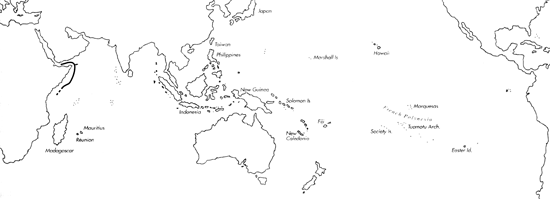Range: Berbera (N. Somalia) to Kisimalo (E. Somalia).
Description: Medium-sized to moderately large, moderately solid to solid. Last whorl ventricosely conical to conical in adult specimens, rather ovate in subadults; outline convex adapically, straight (right side) to slightly concave (left side) below. Aperture wider at base than near shoulder. Shoulder angulate. Spire low, outline concave. Maximum diameter of larval shell 1.1-1.2 mm. Teleoconch sutural ramps almost flat, with 4 weak spiral grooves or obsolete spiral sculpture in late whorls. Last whorl nearly smooth.
| Shell Morphometry | ||
|---|---|---|
| L | 40-69 mm | |
| RW | 0.21-0.48 g/mm | |
| RD | 0.58-0.61 | |
| PMD | 0.75-0.86 | |
| RSH | 0.05-0.11 | |
Colour orange to reddish or blackish brown. Last whorl pattern ranging from a few scattered white tents to 2 spiral tentmark zones, below centre and at base, and several axial groups of tents sometimes fusing into streaks. Darker spiral lines sparsely articulated with small white tents may occur within the dark zones. Basal part of columella white or orange-brown. Apex pink. Late sutural ramps matching last whorl in colour pattern. Aperture white.
Habitat and Habits: No reliable data.
Discussion: C. echo, previously considered a form Macc├Ā, 1988) or subspecies of C. pennaceus (Lauer, 1988), rather deserves recognition as a valid species (Macc├Ā, 1991). C. pennaceus differs in its distinctly narrower larval shell (0.7-0.8 mm) and its usually domed early postnuclear whorls.

C. echo range map
This section contains verbatim reproductions of the accounts of 316 species of Conus from the Indo-Pacific region, from Manual of the Living Conidae, by R÷ckel, Korn and Kohn (1995). They are reproduced with the kind permission of the present publisher, Conchbooks.
All plates and figures referred to in the text are also in R÷ckel, Korn & Kohn, 1995. Manual of the Living Conidae Vol. 1: Indo-Pacific Region.
The range maps have been modified so that each species account has it own map, rather than one map that showed the ranges of several species in the original work. This was necessary because each species account is on a separate page on the website and not confined to the order of accounts in the book.